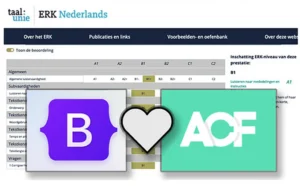In the ever-changing world of front-end development, frameworks come and go—but Bootstrap has stood the test of time. I’ve been working with it for over a decade, and it’s still one of my go-to tools when building smart, scalable, and user-friendly interfaces—especially when paired with WordPress and Advanced Custom Fields (ACF).
Most recently, I used Bootstrap to power a deceptively simple (but technically elegant) solution for a multilingual educational platform—migrating from Drupal to WordPress Multisite while preserving a complex interactive scoring grid. And the result? A lean, intuitive interface that delivered for both end users and developers.
Why Bootstrap Still Works (Really Well)
Bootstrap gets a bit of a bad rep in design circles—some say it’s bloated, generic, or overused. But in the hands of someone who knows how to bend it to their will, it’s a powerhouse.
Here’s why I still reach for it:
- It’s fast – I can build and prototype responsive layouts in minutes.
- It’s reliable – Tried, tested, and cross-browser friendly.
- It plays well with WordPress & ACF – Making content-editable layouts that stay clean and structured.
Whether I’m building custom themes, styling out ACF content blocks, or creating modular templates for clients, Bootstrap gives me the tools to build something solid—and then get out of the way.
Case Study Highlight: Smart Tables with Bootstrap + ACF
One of my favourite Bootstrap wins came in a project for Taalunie’s ERK scoring tool. The goal was to let educators practice scoring student work, and instantly receive feedback based on their selection—across 100+ examples.
The problem? No existing plugin or block could handle the logic or layout we needed.
Rather than going down the road of building a custom plugin (which would have cost more and taken longer), I did what I always try to do: solve it with the tools we already had.
Here’s how:
- Used ACF to build a structured input system for the examples
- Used Bootstrap’s grid and collapse components to build an interactive, expandable table
- Used custom CSS and classes to control what showed up when and where—without heavy JavaScript or extra plugins
The result was an elegant interface that content editors could update with ease, users could interact with intuitively, and developers could look at and say: “Wait… how did you do that?”
Industrial Design Thinking Meets Front-End Development
My background is in Industrial and Product Design, which means I approach websites the same way I’d approach a physical product:
- How will this be used?
- Where are the touchpoints?
- Can we hide the complexity but keep the power?
Bootstrap helps me translate complex UX ideas into working interfaces, especially when you’re juggling the needs of multiple users—developers, content creators, admins, and end users.
The Bootstrap + ACF Sweet Spot
Over the years, I’ve created dozens of reusable Bootstrap-based templates that work seamlessly with ACF. It’s a workflow I use again and again because:
- ACF gives clients control
- Bootstrap gives me structure
- Together, they give us flexibility without chaos
Whether it’s nested collapsible panels, responsive data grids, or clean UI components, this combo lets me build sites that look custom but don’t break the bank.
Final Thoughts
Ten years in, and Bootstrap is still one of the most effective tools in my kit. Paired with WordPress and ACF, it becomes a secret weapon for building scalable, user-friendly, and client-editable websites.
If you’re facing a complex layout or looking for a flexible front-end framework that just works—don’t write Bootstrap off. Sometimes, the best solution isn’t the flashiest—just the one that works beautifully and silently in the background.
Want to see it in action? Check out the live scoring tool here.




